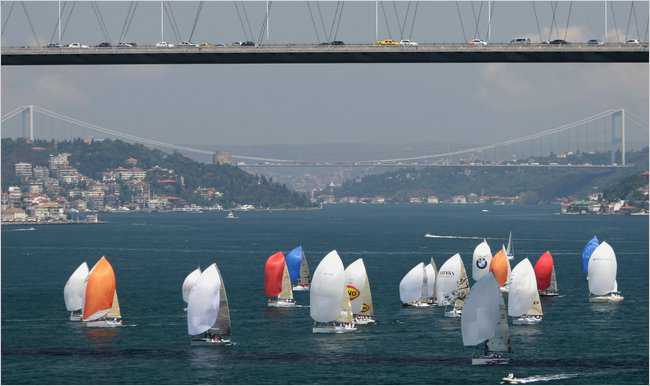By BRAD SPURGEON
Heading into the Turkish Grand Prix this weekend, Formula One teams and their personnel have been referring to the race as a return to Europe after the first three races were in Australia and Asia. Although Istanbul, the majestic city outside of which the race takes place, has a foot in both Asia and Europe, the racetrack itself is technically in Asia.

Associated Press – The Bosporus Strait, which links Europe with Asia, in Istanbul, Turkey.
In fact, it is not the easiest race for spectators to attend. Traveling to and from the circuit from the city at rush hour may mean long traffic jams across the Bosporus bridges — or taking a car ferry — that can make the trip last more than two hours. But for those who enjoy mixing tourism and races, few Grand Prix venues equal the stop in Istanbul.
“Istanbul is one of the most interesting cities in the world and the track itself has some of the best facilities on the calendar,” said Colin Kolles, director of the Hispania team.
Turkey has a growing importance in the car-manufacturing industry. Many carmakers — and the Pirelli tire company, which provides tires to the teams — have factories in the country. According to a recent industry report, “the automotive sector has become the country’s leading exporter, with total exports of $16.9 billion in 2009, which constituted 17.4 percent of Turkey’s total export revenues.”
Moreover, car sales are booming along with the Turkish economy. According to a recent article in the New York Times, “Stockbrokers endure four-month waiting lists to pay as much as $150,000 for top-of-the-line Audis and BMWs — or twice the manufacturer’s price after taxes.”
But the motor-racing culture in Turkey is small, and the Formula One track was the first major road racing track in the country. It was designed by the Formula One track architect of choice, Hermann Tilke, and inaugurated in August 2005 with the first Turkish Grand Prix. Unlike many of the other Tilke tracks, this one receives near universal praise from the drivers. It has just about everything: rolling hills, winding corners — one of which is the longest in the series — and flat-out straights. The combination has made several drivers compare it with the track that is the traditional favorite, Spa-Francorchamps in Belgium.
“Turn 8 is one of the most challenging corners of the year,” Nico Rosberg, a driver at the Mercedes team, said of the long corner. “It’s taken at full throttle for over eight seconds, with forces of up to 5G. If I had to create a fantasy Formula One circuit, this corner would definitely be included.”
Unfortunately, however, the race in Turkey has been one of the least attended on the calendar. Not only is there little racing culture, but ticket prices are prohibitively expensive for the average Turk.
The price of tickets along the straight is half an average monthly salary.
“I love Formula One,” said a longtime fan who lives in Istanbul. “But I have never been to the race just because I cannot afford to buy a ticket.”
If the race is full of contrasts, it is a measure of the city itself. Istanbul is the largest city in Turkey, and with a population of 13 million, it is the second-most-populous city proper in the world. It is the cultural, economic and financial center of Turkey and has been a crossroads of Asia and Europe for millenniums.
First known as Byzantium, Istanbul has undergone changes of empire and culture, from being the capital of the Roman Empire (when it was known as Constantinople) to that of the Byzantine Empire, the Latin Empire and the Ottoman Empire. Traces of all these periods are visible in the buildings, walls and ruins spread over the hills of the city. Istanbul ceased to be the capital of Turkey in 1923, when Ankara became the capital city of the new Republic of Turkey.
Istanbul remains a center of cultural life and dining, and its great boulevards and shopping districts, like Istiklal Street and the Grand Bazaar and Blue Mosque, have more than enough attractions to fill the time that spectators spend away from the track on a race weekend.
via Paddock Postcard – Istanbul, a City at Continental Crossroads – NYTimes.com.

Leave a Reply